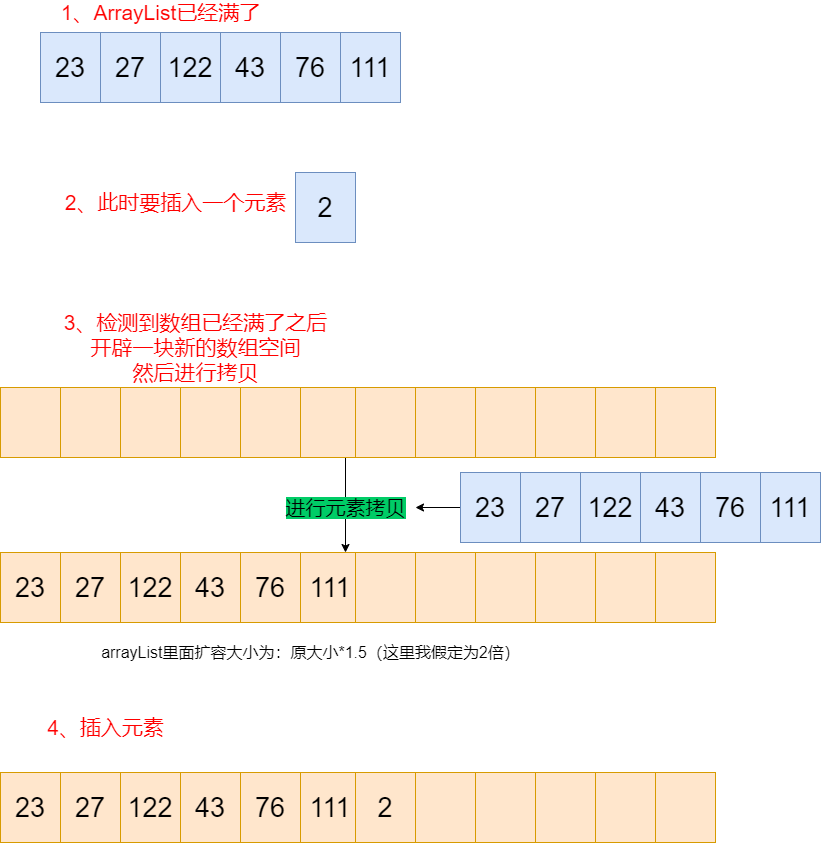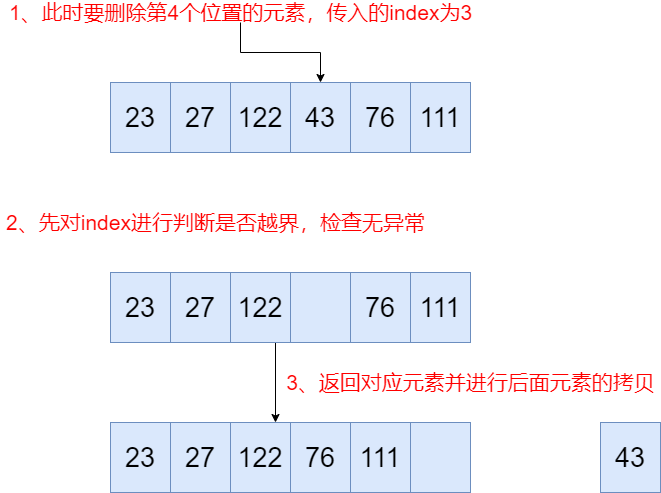一文直接带你吃透 ArrayList
ArrayList 是日常开发中相当常见、面试也相当常考的一种 JDK 集合类,了解并熟悉、甚至能实现一个 ArrayList 对面试、提升自己编码功底大有益处。
一、写给小白 ArrayList 简单使用技巧
这部分是 ArrayList 的简单使用技巧,主要是介绍 ArrayList 的几个常见方法。
1
2
3
4
5
6
7
8
9
10
11
12
13
14
15
16
17
18
19
20
21
22
23
24
25
26
27
28
29
30
31
32
|
/**
* 编写一个ArrayList的简单实用demo
* ArrayList 的常见方法包括:
* add(element):添加元素
* get(index):获取下标元素
* remove(index):移除下标对应元素
* set(index,element):将index处的元素修改为element
*/
public class arrayList {
public static void main(String[] args) {
// 创建 ArrayList 的对象
ArrayList al = new ArrayList();
// 添加元素
al.add("finky");
// 构造随机数并进行添加
Random rnd = new Random();
for (int i = 0; i < 20; i++) {
al.add(rnd.nextInt(1000));
}
// 取出ArrayList里的元素进行打印
for (int i = 0; i < al.size(); i++) {
System.out.print(al.get(i) + " ");
}
// 修改0号index成的元素为doocs
System.out.println();
al.set(0, "doocs");
System.out.println(al.get(0));
// 移除“doocs”元素
al.remove(0);
System.out.println(al.get(0));
}
}
|
1
2
3
4
|
// 这是上面打印后的demo,可以看到第0处下标元素先是修改成了doocs,进行移除后,第0处下标元素变成了912
finky 912 922 284 305 675 565 159 109 73 298 491 920 296 397 358 145 610 190 839 845
doocs
912
|
二、ArrayList 的源码分析
我们来看看 ArrayList 的源码:
1、来看看 ArrayList 的初始化:
1
2
3
4
5
6
7
8
9
10
11
12
13
14
15
16
17
18
19
20
21
|
// ArrayList 初始化时默认大小为10
private static final int DEFAULT_CAPACITY = 10;
// 直接初始化的话一个空数组
private static final Object[] EMPTY_ELEMENTDATA = {};
// 初始化ArrayList,传入初始化时的大小
public ArrayList(int initialCapacity) {
if (initialCapacity > 0) {
this.elementData = new Object[initialCapacity];
} else if (initialCapacity == 0) {
this.elementData = EMPTY_ELEMENTDATA;
} else {
throw new IllegalArgumentException("Illegal Capacity: "+
initialCapacity);
}
}
// 如果不传入大小的话就默认大小是10,那么这里就有一个问题:我们上面插入的元素超过了10,继续插入元素就会进行拷贝扩容,性能不是特别高。所以我们一般情况下初始化时给定一个比较靠谱的数组大小,避免到时候导致元素不断拷贝
public ArrayList() {
this.elementData = DEFAULTCAPACITY_EMPTY_ELEMENTDATA;
}
|
总结一下 ArrayList 初始化:我们创建 ArrayList 对象时,如果没有传入对应的大小,就会默认创建一个元素大小为 10 的数组,下次插入元素超过 10 时,会进行数组的拷贝扩容,这样性能消耗太高,所以建议就是在初始化时给定一个不要太小的容量大小。==
2、 ArrayList 的 add 方法:
先上add 方法的代码:
1
2
3
4
5
6
7
8
9
10
11
12
13
14
15
16
17
18
19
20
21
22
23
24
25
26
27
28
29
30
31
32
33
|
public boolean add(E e) {
ensureCapacityInternal(size + 1); // Increments modCount!!
elementData[size++] = e;
return true;
}
public void add(int index, E element) {
rangeCheckForAdd(index);
ensureCapacityInternal(size + 1); // Increments modCount!!
System.arraycopy(elementData, index, elementData, index + 1,
size - index);
elementData[index] = element;
size++;
}
public void add(E e) {
checkForComodification();
try {
int i = cursor;
ArrayList.this.add(i, e);
cursor = i + 1;
lastRet = -1;
expectedModCount = modCount;
} catch (IndexOutOfBoundsException ex) {
throw new ConcurrentModificationException();
}
}
private void rangeCheck(int index) {
if (index < 0 || index >= this.size)
throw new IndexOutOfBoundsException(outOfBoundsMsg(index));
}
}
|

先判断当前数组元素是否满了,如果塞满了就会进行数组扩容,随后进行数组拷贝。
再然后插入元素,同时对应的 index++。
3、瞧瞧 ArrayList 的 set 方法:
1
2
3
4
5
6
7
8
9
10
11
12
13
14
15
16
17
18
|
public E set(int index, E element) {
rangeCheck(index);
E oldValue = elementData(index);
elementData[index] = element;
return oldValue;
}
public void set(E e) {
if (lastRet < 0)
throw new IllegalStateException();
checkForComodification();
try {
ArrayList.this.set(lastRet, e);
} catch (IndexOutOfBoundsException ex) {
throw new ConcurrentModificationException();
}
}
|
1、先进行 index 判断是否越界,如果没有越界的话获取原来的旧的值
2、进行替换并返回该位置原来的旧的值
4、ArrayList 的 get 方法:
1
2
3
4
5
|
public E get(int index) {
rangeCheck(index);
return elementData(index);
}
|
进行 index 是否越界的判断,然后去取对应下标的值。
5、ArrayList 的 remove 方法:
1
2
3
4
5
6
7
8
9
10
11
12
13
14
15
16
17
18
19
20
21
22
23
24
25
26
27
28
29
30
31
32
33
34
35
36
|
public void remove() {
if (lastRet < 0)
throw new IllegalStateException();
checkForComodification();
try {
ArrayList.this.remove(lastRet);
cursor = lastRet;
lastRet = -1;
expectedModCount = modCount;
} catch (IndexOutOfBoundsException ex) {
throw new ConcurrentModificationException();
}
}
public E remove(int index) {
// 进行index是否越界的判断
rangeCheck(index);
checkForComodification();
E result = parent.remove(parentOffset + index);
this.modCount = parent.modCount;
this.size--;
return result;
}
public E remove(int index) {
rangeCheck(index);
modCount++;
E oldValue = elementData(index);
int numMoved = size - index - 1;
if (numMoved > 0)
System.arraycopy(elementData, index+1, elementData, index,
numMoved);
elementData[--size] = null;
return oldValue;
}
|

1、先进行下标是否越界的判断,获取 index 处的元素值(这是要删除的值)
2、然后进行元素拷贝,把 index 后面的元素往前拷贝
6、关于 ArrayList 动态扩容和数组拷贝:
1
2
3
4
5
6
7
8
9
10
11
12
13
14
15
16
17
18
19
20
21
22
|
private void ensureCapacityInternal(int minCapacity) {
ensureExplicitCapacity(calculateCapacity(elementData, minCapacity));
}
private void ensureExplicitCapacity(int minCapacity) {
modCount++;
if (minCapacity - elementData.length > 0)
grow(minCapacity);
}
private void grow(int minCapacity) {
// overflow-conscious code
int oldCapacity = elementData.length;
// 扩容的代码:这里做了位运算,相当于数组扩容了1.5倍
int newCapacity = oldCapacity + (oldCapacity >> 1);
if (newCapacity - minCapacity < 0)
newCapacity = minCapacity;
if (newCapacity - MAX_ARRAY_SIZE > 0)
newCapacity = hugeCapacity(minCapacity);
// 随后进行元素拷贝
elementData = Arrays.copyOf(elementData, newCapacity);
}
|
现在假定场景:arraylist 中已经有 10 个元素类,要放第 11 个元素。
此时进行容量检测,出现问题:空间大小不够。
解决方法:此时进行数组扩容右位移 1(相当于总容量多加 1.5 倍)扩容,老的大小+老大小的一半,进行元素拷贝
三、来仿照 JDK 源码写一个自己的 ArrayList 把
1
2
3
4
5
6
7
8
9
10
11
12
13
14
15
16
17
18
19
20
21
22
23
24
25
26
27
28
29
30
31
32
33
34
35
36
37
38
39
40
41
42
43
44
45
46
47
48
49
50
51
52
53
54
55
56
57
58
59
60
61
62
63
64
65
66
67
68
69
70
71
72
73
74
75
76
77
78
79
80
81
82
83
84
85
86
87
88
89
90
91
92
93
94
95
96
97
98
99
100
101
102
103
104
105
106
107
108
109
110
111
112
113
114
115
116
117
118
|
public class OwnArrayList<E> {
private E data[];
private int size;
public OwnArrayList(int capacity) {
data = (E[]) new Object[capacity];
size = 0;
}
// 初始化是默认设置大小为20
public OwnArrayList() {
this(20);
}
// 获取数组容量
public int getCapacity() {
return data.length;
}
// 获取数组元素个数
public int getSize() {
return size;
}
// 判断数组是否为空
public boolean isEmpity() {
return size == 0;
}
// 获取index索引位置的元素
public E get(int index) {
if (index < 0 || index >= size)
throw new IllegalArgumentException("add failed,the index should >= 0 or <= size");
return data[index];
}
// 修改index索引位置的元素为e
public void set(int index, E e) {
if (index < 0 || index >= size)
throw new IllegalArgumentException("add failed,the index should >= 0 or <= size");
data[index] = e;
}
// 在数组中间插入一个元素
public void add(int index, E element) {
if (size == data.length) {
throw new IllegalArgumentException("AddLast failed,array has already full");
}
if (index < 0 || index > size) {
throw new IllegalArgumentException("add failed,the index should >= 0 or <= size");
}
for (int i = size - 1; i >= index; i--) {
data[i + 1] = data[i];
}
data[index] = element;
size++;
}
// 向数组元素末尾添加一个元素
public void addLast(E element) {
add(size,element);
}
// 在数组头部插入一个元素
public void addFirst(E element) {
add(0, element);
}
// 判断是否含有元素
public boolean contains(E e) {
for (int i = 0; i < size; i++)
if (data[i] == e)
return true;
return false;
}
// 查找元素e的位置
public int find(E e) {
for (int i = 0; i < size; i++) {
if (data[i] == e) {
return i;
}
}
return -1;
}
// 删除index位置的元素
public E remove(int index) {
if (index < 0 || index > size) {
throw new IllegalArgumentException("index should be 0 to size");
}
E remove_element = data[index];
for (int i = index + 1; i < size; i++) {
data[i - 1] = data[i];
}
size--;
return remove_element;
}
// 删除末尾元素
// 注意:这是逻辑删除,但是size的大小已经做了相应的减少,所以从实际意义上我们外界并不能访问到末尾元素的值
public E removelast() {
return remove(size - 1);
}
// 删除开头元素
public E removeFirst() {
return remove(0);
}
// 将数组空间的容量变成newCapacity大小
private void resize(int newCapacity) {
newCapacity = getCapacity()*2;
E[] newData = (E[]) new Object[newCapacity];
for (int i = 0; i < size; i++)
newData[i] = data[i];
data = newData;
}
}
|
四、面试时关于 ArrayList 要说的事
如果有人问你 ArrayList 知多少,我觉得可以从这几个方面出发:
ArrayList 的底层是基于数组进行的,进行随机位置的插入和删除、以及扩容时性能很差,但进行随机的读和取时速度却很快。
接着可以从源码的角度分析 add、remove、set、get、数组扩容拷贝的过程场景。
最后也是特别重要的一点,就是要积极掌握主动性,延伸出 LinkedList 的特点、源码、两者间的对比等。
注:当需要动态数组时我们通常使用 ArrayList 而不是使用类似的 vector,这里有一点说明一下,就是尽管 Vector 的方法都是线程安全的,但其在单线程下需要花费的时间更多,而 ArrayList 尽管不是线程安全的,但其花费的时间很少。
终:参考资料
- JDK 集合框架 ArrayList 源码
- 《Core.Java.Volume.I.Fundamentals.11th.Edition》




